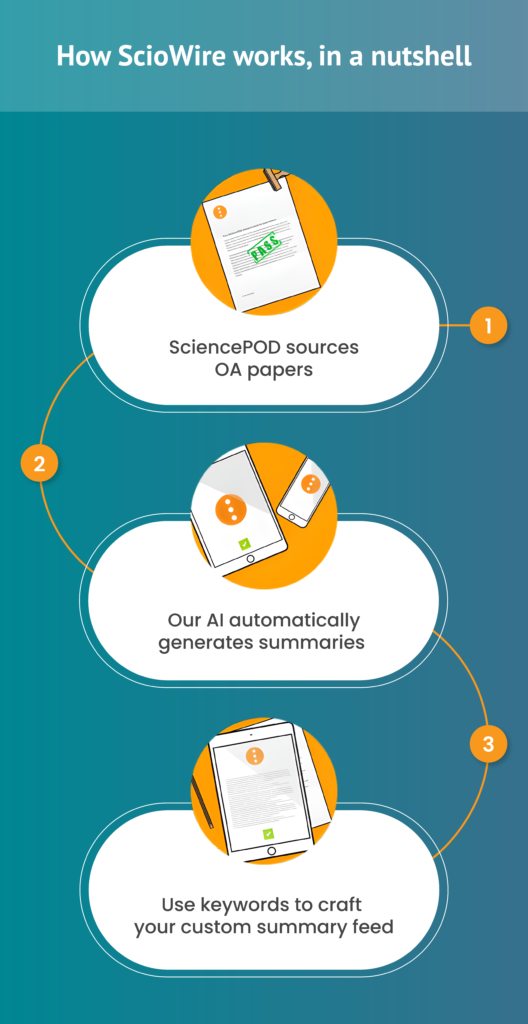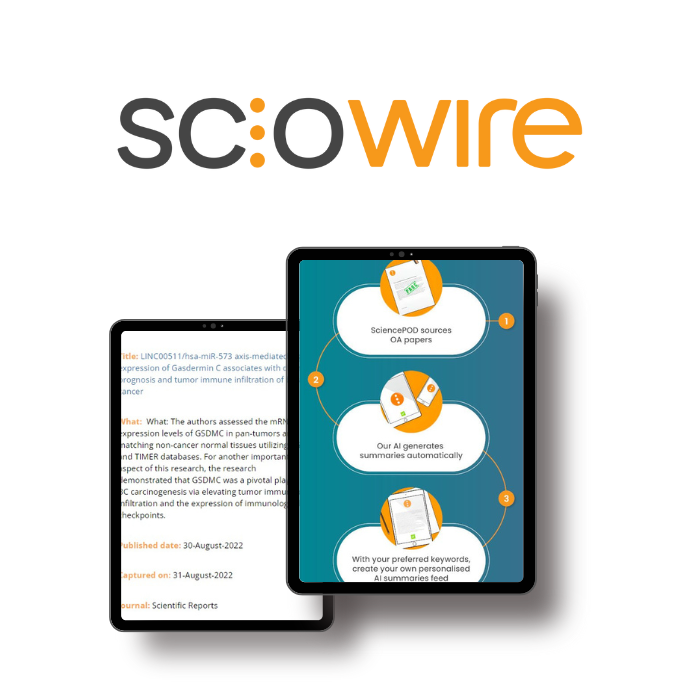SciencePOD’s new research amplification solutions, a boon for open science
Why are so many scientists still chasing their tail? They can never find enough time to read all the relevant past studies they need, let alone keep an eye on the latest research. On the upside, this tail-chasing dilemma creates an opportunity to introduce new business models for services that help scientists keep up-to-date and amplify the impact of their research. On the occasion of the 2022 Frankfurt Book Fair, SciencePOD is introducing ScioWire beta, a new artificial intelligence (AI) solution designed to empower every scientist – and their publishers – to increase the impact of their work. How? By creating summaries of individual published papers automatically and on a large scale. This double-edged solution provides both a newsfeed of the latest research and on-demand AI summarisation.
Beyond open-access publications
The ScioWire launch comes at the right time. It is taking place as open access (OA) is increasingly shaking up the old business models of scholarly publishers. Dwindling subscription revenues leave them with no other option but to explore new business models that better serve the scientific community. This approach makes scientist-centric solutions increasingly attractive. Specifically, new product opportunities are emerging for the post-publication stage – the stage associated with dissemination, discoverability and ultimately, research impact. For new solutions, we can thank advances in natural language processing applications in the field of automated summarisation.
This new context calls for new business models centred around the base-unit of scientific record – the research paper. Innovations associated with the nature of the scientific record and its wider availability cover micro-publications, open peer-review and preprints. Meanwhile, technology is also increasingly dictating the way scientific data is recorded, in line with FAIR principles, to allow for machine readability and cross-analysis of the entire scientific output. Despite these innovations, wider scientific progress offering cross-fertilisation opportunities remains out of reach for most scientists, who remain siloed— often self-confined to their field of expertise due to the massive volume of information to digest.

New ways of consuming research with AI summarisation
As AI technology matures, now is the time to re-think how scientists consume research. There is an opportunity to make hay of the benefits of natural language processing to increase the discoverability and dissemination of research studies and amplify their impact. AI summaries are quickly generated, easy to digest and share – they can act as a preview for individual research studies. One way to productise AI summarisation is by designing a newsfeed to help scientists monitor latest advances in research. That’s what SciencePOD has done with its new solution: ScioWire beta – delivering a keyword-customised newsfeed of the latest OA research. Each feed item is made up of automatically generated summaries of the latest OA papers, complete with context. ScioWire is an affordable productivity tool designed to help scientists select relevant studies more quickly.
Why use AI summarisation?
Before ScioWire, scientists interested in monitoring the latest advances had to rely on abstracts to separate the wheat from the chaff. The trouble is abstracts often give a subjective view of the study – more often than not, with the intention of supporting the authors’ next funding application. By contrast, summaries reflect the key findings of each paper. What is unique about SciencePOD’s own AI summarisation tool, SUMMSci, is that it goes one step further by delivering contextualised summaries.
Through a partnership with Juan-Manuel Torres-Moreno, senior researcher from the Laboratoire d’Informatique d’Avignon at the eponymous French Université, SciencePOD’s solution reflects the years of experience of this world expert in summarisation. The summaries of academic studies are generated automatically within seconds. And they come complete with context: keywords, acronyms elucidated and lay definitions of technical terms. In addition, they feature a second type of ‘quick-to-consume’ information – research highlights that answer key questions: Who did the work? Where and when did they publish? What did they find? How did they find these results? What are the future research steps?
Attention economy
Summaries represent the building blocks of research amplification strategies. They are proven to draw the attention of readers to the original research, yielding much higher impact than the full-size article on its own. However, AI summaries are by no means a substitute for the full text. Instead, they act as a ‘teaser’ to help readers decide whether or not to read the details of the full paper.
These snackable, digestible versions of scientific papers fit the evolving content consumption habits and preferences of scientists who, on average,
only have 5- to 15-minute slots of time throughout the day to consume content. The new solution can thus enhance researchers’ productivity – when preparing a review paper or doing background bibliographical research, for example – which is critical to the success of their work. That’s where ScioWire goes one step further in providing scientist-centric features, by offering AI summarisation on-demand and research monitoring functionality in the form of a customisable newsfeed.
Impact at scale
Research impact matters to scientists as well as scholarly publishers. In addition to relying on SciencePOD’s global community of science and medical writers to create summarised research highlights ‘by hand’, publishers are exploring how AI summarisation technologies can help disseminate large volumes of article summaries linked to the original source research paper.
In addition, SciencePOD willhelp with distribution by offering publication to its own ScioWire web magazine and make its content available through a personalised widget embedded in online portals hosting communities of researchers. Combining attention-grabbing AI summaries and distribution networks, SciencePOD’s new solutions will empower publishers to offer greater value to authors and to draw wider audiences to the latest research studies they publish at an unprecedented scale.
Sabine Louët, Founder and CEO of science content creation company, SciencePOD.
Reproduced with kind permission from Research Information. See the original source article here

